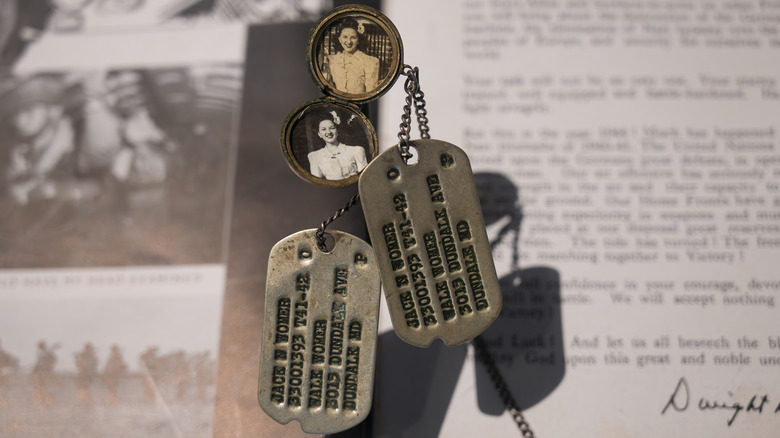Why Did WW2 Dog Tags Have A Notch? Here's What It Was For
Service members wear military identification tags (aka "dog tags") so they can be positively and easily recognized if they're too wounded to speak or killed in action. The most current version is oval-shaped and has their name, service number, blood type, and religious preference embossed on them.
The Army issued its first general order in 1906 requiring soldiers to wear a disc-shaped ID tag along with the rest of their uniforms (why are they called fatigues?). However, they were unofficially worn dating back to the Civil War by soldiers terrified of being buried as an unknown in a mass grave. The first official version was the size of a half-dollar and embossed with a soldier's name, rank, company, and regiment or corps. Like today's tags, there was no notch on them. Soldiers were only given one tag until World War I, when they were given two — one would stay with their body, and the second to adorn their coffin.
The "dog tag" nickname wouldn't come for another 30 years, but it had become the standard monicker by the time World War II started. During the war, every set of dog tags issued was mechanically stamped with a voluminous amount of information, including the soldier's name, rank, service number, blood type, religion (if they wanted), the letter "T" if they'd received a tetanus vaccination, and an emergency-notification name and address. And all tags had a single notch on one side.
The Addressograph Model 70 was the reason for the notch
Now, you might have heard the notch was used to line up each tag properly into a Graphotype stamping machine, but that's not quite the case. After a soldier became injured, the medics needed a way to obtain all the information on the tags quickly and more accurately than writing it all down by hand. They used a pistol-type imprinting device known as the Model 70 Addressograph.
The tag was placed in the Addressograph using the notch to line it up correctly and hold it securely. Then the medical document was inserted and aligned with the tag. Squeezing the pistol grip raised the platen against the tag's embossed characters. That information was then imprinted into the document using a carbon-paper ribbon (one of the old pieces of technology that still work today) running through the Addressograph. In essence, it used very old-school printing-press technology in a compact form. Remember, this was the 1940s ... long before instant photos, digital scanning, or high-tech ID cards were even a glimmer.
Except for the Navy, all branches of the U.S. military still issue identification tags. In January 2019, tags for Army and Air Force service members started including the same information — the soldier's name, Defense Department ID number, blood type, and religious preference. Tags for Marines are slightly different, with additional information like gas mask size, and use their first initial instead of their full name. None of them have notches.
